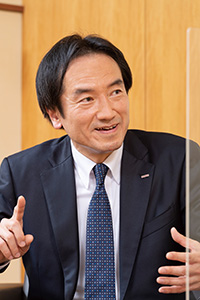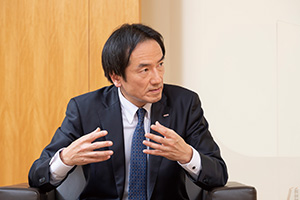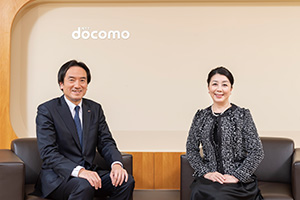 |
|||
|
|
|||
|
View from the Top Vol. 19, No. 3, pp. 1–6, Mar. 2021. https://doi.org/10.53829/ntr202103tp1
Let°«s Change, Challenge, and Implement for Creating a °»Wellbeing Society°…OverviewNTT DOCOMO became a wholly owned subsidiary of NTT at the end of 2020. With the launch of 5G (5th-generation mobile communication system) services, its business environment is undergoing a period of major change. Society is also changing due to the novel-coronavirus pandemic, such as acceleration of digital transformation and spread of remote working. We asked Naoki Tani, executive vice president, chief technology officer, executive general manager of R&D Innovation Division of NTT DOCOMO, about the company’s efforts to address social issues using technology and how he communicates with employees in this period of change. Keywords: wellbeing, cyber-physical fusion, Mobile Spatial Statistics Technology and R&D will lead to creation of a happier future—First, tell us about the environment surrounding NTT DOCOMO. We can talk about the environment surrounding NTT DOCOMO from two perspectives: the business environment surrounding NTT DOCOMO and that surrounding the NTT Group. As for the first perspective, in 2020, NTT DOCOMO and other communication companies began providing 5th-generation mobile communication system (5G) services, and the competitive environment changed accordingly. As the second perspective, on December 29, 2020, NTT DOCOMO became a wholly owned subsidiary of NTT. 5G services do not simply provide new technologies to society, they also aim to address social issues and create new value. For this reason, in February 2018, NTT DOCOMO initiated the DOCOMO 5G Open Partner Program, which provides partner companies and organizations (referred as “partners”) with information on 5G technologies and specifications as well as a place for exchanging ideas among them. In addition, we established the DOCOMO 5G Open Lab, where partners developing 5G services can test their services with 5G equipment such as 5G radio stations. In September 2019, we started our 5G pre-commercial services to enable us and partners to create business using the same network equipment and frequency bands as 5G commercial services and enable users to experience the same environment as 5G commercial services. In March 2020, we launched our fully-fledged 5G commercial services. Different companies have begun providing 5G services and are promoting 5G’s key features, namely, high speed and large capacity. NTT DOCOMO is focusing on solving social issues and creating new value with 5G as well as offering attractive billing plans for users. We have also been leading the international standardization of 5G together with interested parties around the world, and we want to actively promote international standardization beyond 5G, i.e., Beyond 5G and 6G. NTT DOCOMO has become a wholly owned subsidiary of NTT, so we want to put in place a thorough system so that the research and development (R&D) activities of both companies will be more closely integrated than ever before. NTT DOCOMO is an operating company: we operate in an environment in which customer needs can be directly reflected in R&D and the R&D results can be directly fed back to businesses. Strengthening R&D cooperation between NTT and NTT DOCOMO makes it possible to widen the communication pipeline between the R&D and business departments. In this manner, we want to make the cooperation more coordinated. I believe that the purpose of NTT DOCOMO is to promote communication between people. To accelerate our R&D, we have set up the “wellbeing society” as a vision for the future, and we are engaged in R&D that will contribute to building a people-friendly society where individual needs can be carefully addressed. In other words, our efforts to address social issues will lead to the creation of a society in which people can live happy, enjoyable lives. Our approach is to build an ecosystem based on three perspectives: industry, society, and individuals. We will develop industries that benefit people, create a social environment in which people can live comfortably, and support people in demonstrating their abilities and live enjoyable and happy lives. I believe that it is our mission to think about what kind of R&D is necessary to meet these goals, and we want to share these goals in our R&D collaboration with NTT.
—Could you give us an example of R&D for creating a “wellbeing society”? The current focus of our R&D on technologies and services that will create such society is a framework called cyber-physical fusion. This framework will also contribute to actualizing the Innovative Optical and Wireless Network (IOWN) being advocated by the NTT Group. People, things, and events in the real world (physical space) are digitized, their data are acquired and accumulated in cyberspace, those data are analyzed to predict the future, and the acquired knowledge is fed back (actuating) to the real world. By repeating the above-mentioned process as a loop, it is possible to create value for people, industries, and societies in the real world, such as providing new experiences, improving efficiency and productivity, facilitating optimization, and ensuring safety and security. NTT DOCOMO is also taking up the challenge of evolving core technologies to enable cyber-physical fusion. These core technologies include artificial intelligence, which predicts the future and generates knowledge by linking various acquired and accumulated data, Internet of Things (IoT) and device technologies, which provide a means of digitizing the real world and knowledge feedback, and a network that connects the real world and cyberspace. We want to create a “wellbeing society” by evolving these core technologies and establish a platform that can be shared across industries. As the spread of the novel coronavirus generates restrictions on real-world activities, the shift to the virtual world and online communication is a continuing trend. Following this trend, we hosted “docomo Open House 2021,” held from February 4 to 7, 2021, in a completely online format and provided virtual booths that attendees could visit and enjoy the event and exhibitions. For example, we set up a booth where attendees could experience traveling abroad and another in which they could enjoy sports and music with free-viewpoint videos. Sometimes you may want to see more of or actually see with your own eyes things that you experienced virtually. I think it’s important to bring out this feeling by providing a virtual world. The fact that the real world comes after the virtual world means that the greater the value of being able to experience something virtually, the greater the value of it in the real world. I sometimes hear people say that real-world experiences will be replaced with virtual ones, but I beg to differ; there will be more cases in which real social activities are invigorated through virtual ones.
All employees have the potential to unlock the future—Expectations concerning efforts to improve the real world through the fusion of the real and virtual worlds are rising. Is the reader aware of the Mobile Spatial Statistics? Among the news about the novel coronavirus, the rate of increase or decrease in the number of people at major train stations has been reported in Japan, and statistical information calculated using our Mobile Spatial Statistics is also used. The Mobile Spatial Statistics is a population statistics service created using the mechanisms of NTT DOCOMO’s mobile phone network and provides population-distribution data by gender, age group, and place of residence in real-time minus a minimum of one hour in 10-minute increments [1]. We also provide a service that visualizes the population of Japan by using high-speed visualization technology developed by NTT laboratories. Using this service, with search/read speed that is seven-times faster than previously possible, users can smoothly display and browse changes in the population of Japan over time. Gender, age, and place of residence in relation to each square (500 m2) of a mesh covering the whole country can be freely selected and displayed. As an actual example, a forecast model created in combination with data from a partner is used by store owners to understand the population increase or decrease on a certain day in a particular commercial area. As a result, they can predict sales and adjust the production of lunch boxes and delicatessen items to reduce food loss. Moreover, road-management operators can predict the occurrence of traffic jams on managed roads by determining the population increase or decrease on a certain day in a specific area such as a sightseeing spot. That highly accurate traffic-jam-prediction information is also provided to drivers through smartphone apps, etc., helping to eliminate traffic jams. These cases are examples of embodying cyber-physical fusion and creating services by using the foresight in identifying value in accumulated information, planning ability, and analytical ability. Although I have talked about services originating from the R&D Department, NTT DOCOMO has a mechanism in which various ideas of employees can be used in new businesses, and the R&D Department supports this mechanism. We will continue to evaluate the possibility of practical application and commercialization of ideas proposed by employees and make them a reality. In this way, I want to value the possibilities possessed by employees other than those directly involved in R&D and services. I believe their possibilities are waiting to be unlocked. —Can you tell us what you have cherished as a top manager thus far? The social environment has been changing drastically due to the novel-coronavirus pandemic. I think this change gives us an opportunity to continually come up with new ideas. In such a rapidly changing environment, we should consider three important points: “change,” “challenge,” and “implement.” These may be words you often hear, but I have the following viewpoints. Let’s start with “change.” Take a positive mindset that every challenge is an opportunity for change. “Challenge” is to create a story through your own will. It’s important to draw the big picture and act. “Implement” means start quickly with what you can do. It doesn’t matter if you “start small.” The accumulation of experience little by little will produce outstanding results. Since many people at NTT DOCOMO are engaged in R&D, the directions of their work may differ. If that is the case, it is important to return to the starting point. During discussions with employees about work or a project, I often ask, “What are we doing this for?” because I sometimes feel that it is necessary to discuss their work from a broader perspective. At such times, I try to improve communication so that we can share the starting point. It’s very important to listen to employees. Rather than telling them to do something, I always want to hear what they think and feel. When I find it difficult to understand what a person is saying, by listening patiently, I can understand his/her true intention. Even if the discussion becomes complicated, responding candidly with “Hold on. What are we doing this for?” will calm the situation and allow us to return to the starting point, share it, and move forward together. Listening to employees also leads to understanding the diversity and discovering the potential of employees.
Return to the starting point to understand the story and purpose—As your reputation suggests, you seem to be an easy-to-talk-to boss. Although that may be true, sometimes employees are reluctant to talk to me in my position as their boss, so I try to talk to them as much as possible. Since it is difficult to take time for each employee, I try to talk to them during meetings. Also, some employees come to see me by spotting gaps between meetings, and I value that kind of time as much as possible. Since we are teleworking these days, I sometimes feel frustrated because I can’t communicate with employees easily. Regardless, I still try to have the opportunity to speak to people as much as possible. As I said above, while listening to everyone, I have viewed everything positively to allow us to “change,” “challenge,” and “implement.” Prioritization is the key to execute these three points. That is to say, select matters so that you can focus on what you think is important. For example, when creating materials, it is important that they are written so that the purpose of the materials can be understood easily. The next important point is where and to whom to talk and how much time to spend. Bosses and customers—as well as external lectures and management meetings—are completely different. What you can convey in 30 seconds differs from what you can convey in one hour. It is very important to devise a way of communicating that firmly corresponds to these different situations. Figures, design, wording, etc. all need to be applied according to the purpose. Therefore, I often ask the person who created such material a question, “What is this used for?” to remind us of the starting point and allow us to understand its story and purpose. I’m always aware of this question, and I want all employees to be aware of it too.
—As a chief technology officer, please give a few words to researchers/engineers. After joining the company, I worked in the R&D Department of NTT DOCOMO for about 20 years. After working in the Network Department of the Kansai Branch and the IoT Business Department, I returned to the R&D Innovation Division after being away for about nine years. Technology has evolved tremendously over those last nine years. In the IoT Business Department, where I worked until June 2020, I was working with the aim of creating new business models and increasing profit with partners by using new technologies. During that period, I was observing NTT DOCOMO’s R&D from the outside. After assuming the post of chief technology officer last year, I reaffirmed that NTT DOCOMO possesses many outstanding technologies, and these technologies can be used in our business more than ever. I encourage our researchers/engineers to take pride in our own technologies and firmly understand the meaning, significance, and position of those technologies. If you keep doing this, you will find opportunities. There are many situations in which the technologies we possess can help solve social issues. If you find an opportunity, you can only take it. I’d like you to keep in mind the three key points I focused on, namely, “change,” “challenge,” and “implement.” Reference
Interviewee profileCareer highlightsNaoki Tani joined NTT in 1989 and worked in the R&D Department of NTT DOCOMO from 1992 to 2011. He served as head of the Network Department of Kansai Branch from 2011 to 2014, head of the M2M Business Department from 2014 to 2015, head of the IoT Business Department from 2015 to 2020, and executive officer of NTT DOCOMO from 2017 to 2020. He has been in his current position since June 2020 |
|||





